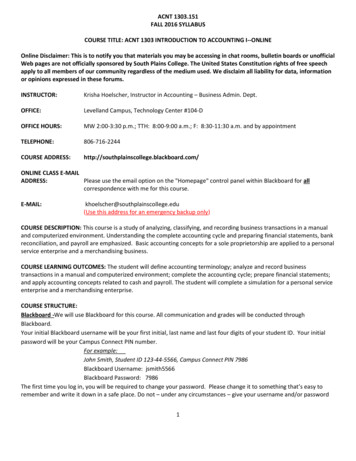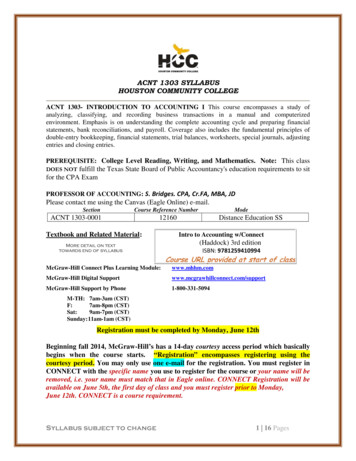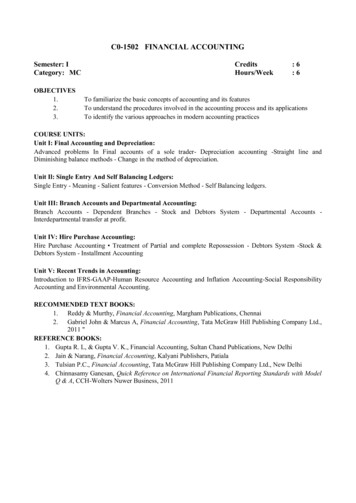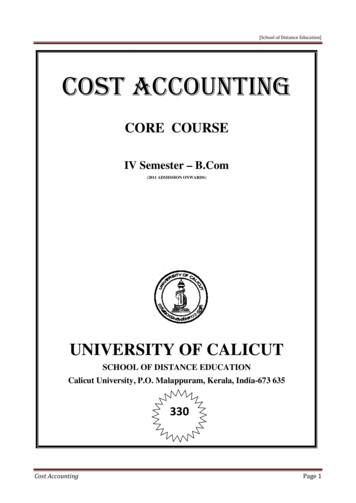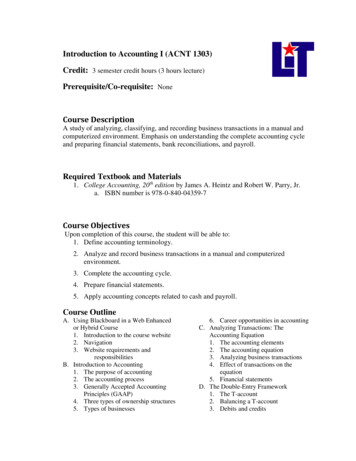
Transcription
Introduction to Accounting I (ACNT 1303)Credit: 3 semester credit hours (3 hours lecture)Prerequisite/Co-requisite: NoneCourse DescriptionA study of analyzing, classifying, and recording business transactions in a manual andcomputerized environment. Emphasis on understanding the complete accounting cycleand preparing financial statements, bank reconciliations, and payroll.Required Textbook and Materials1. College Accounting, 20th edition by James A. Heintz and Robert W. Parry, Jr.a. ISBN number is 978-0-840-04359-7Course ObjectivesUpon completion of this course, the student will be able to:1. Define accounting terminology.2. Analyze and record business transactions in a manual and computerizedenvironment.3. Complete the accounting cycle.4. Prepare financial statements.5. Apply accounting concepts related to cash and payroll.Course OutlineA. Using Blackboard in a Web Enhancedor Hybrid Course1. Introduction to the course website2. Navigation3. Website requirements andresponsibilitiesB. Introduction to Accounting1. The purpose of accounting2. The accounting process3. Generally Accepted AccountingPrinciples (GAAP)4. Three types of ownership structures5. Types of businesses6. Career opportunities in accountingC. Analyzing Transactions: TheAccounting Equation1. The accounting elements2. The accounting equation3. Analyzing business transactions4. Effect of transactions on theequation5. Financial statementsD. The Double-Entry Framework1. The T-account2. Balancing a T-account3. Debits and credits
4. Transaction analysis5. The trial balanceE. Journalizing and Posting Transactions1. Flow of data2. The chart of accounts3. Source documents4. The general journal5. The general ledger6. Finding and correcting errors in thetrial balanceF. Adjusting Entries and the Worksheet1. End-of-period adjustments2. The work sheet3. Finding errors on the worksheet4. Journalizing adjusting entries5. Posting adjusting entries6. Methods of accountingG. Financial Statements and the ClosingProcess1. The financial statements2. The closing process3. Post-closing trial balance4. The accounting cycleGrade Scale90 – 10080 – 8970 – 7960 – 690 – 59ABCDFCourse EvaluationFinal grades will be calculated according to the following criteria:4 regular Exams80%Comprehensive Final Exam20%Course Requirements1. Build accounting foundations necessary to analyze and record businesstransactions.2. Prepare financial statements such as the Balance Sheet, Income Statement and theStatement of Owner’s Equity.3. Weekly Access to Blackboard Website2
Course Policies1. Purchase required materials including textbook and supplements.2. Proper classroom decorum will be maintained at all times.3. Absolutely no disruptions will be tolerated. Disruptive students will be asked toleave.4. No food, drinks, or use of tobacco products in class.5. Beepers, telephones, headphones, and any other electronic devices must be turnedoff while in class.6. Do not bring children to class.7. Homework Policy: All homework should be completed and brought to class forreview by the date assigned by the instructor. Homework may be collected andgraded randomly.8. Assignments Policy: Late assignments will not be accepted. Students that turn inan assignment late will receive a grade of ‘0’. Occasionally, the instructor mayhave an assignment to be completed in-class for a grade. If you are absent for theclass when an assignment is given, you will receive a zero. Any missed in-classassignments and/or quizzes will be not be given the opportunity to be made-up.9. Test Policy: Makeup exams will not be given. Missed exams will result in agrade of ‘0’.10. Attendance Policy: Attendance will be taken at the beginning of each classperiod. If a student is tardy to class or misses a class altogether, that student is stillresponsible for all work and/or discussion missed. It is the student’sresponsibility to determine what it is he or she missed, not the instructor’s. Theinstructor will not take additional time outside of class to inform an absentstudent of what occurred during the class period. The best source of missedmaterial or assignments is a classmate.11. Classroom Policy: Classroom computers are to be used exclusively foreducational purposes during the scheduled class period. Unauthorized use of theinternet is prohibited, such as social networking (MySpace, Facebook, etc.),gaming, music download sites and pornography. Feel free to use the classroomprinter as needed, however, there should be no printing once the class period hasbegun.12. If you wish to drop a course, the student is responsible for initiating andcompleting the drop process. If you stop coming to class and fail to drop thecourse, you will earn an ‘F’ in the course.13. Additional class policies as defined by the individual course instructor.3
14. Course Schedule is tentative, and test dates may deviate based on the attainedlevel of student mastery.Disabilities StatementThe Americans with Disabilities Act of 1992 and Section 504 of the Rehabilitation Act of1973 are federal anti-discrimination statutes that provide comprehensive civil rights forpersons with disabilities. Among other things, these statutes require that all students withdocumented disabilities be guaranteed a learning environment that provides for reasonableaccommodations for their disabilities. If you believe you have a disability requiring anaccommodation, please contact the Special Populations Coordinator at (409) 880-1737 orvisit the office in Student Services, Cecil Beeson Building.Course ntroductionIntroduction to AccountingAnalyzing Transactions: The Accounting EquationAnalyzing Transactions: The Accounting EquationEXAM IThe Double-Entry FrameworkThe Double-Entry FrameworkThe Double-Entry FrameworkJournalizing and Posting TransactionsJournalizing and Posting TransactionsJournalizing and Posting TransactionsJournalizing and Posting TransactionsEXAM IIAdjusting Entries and the Work SheetAdjusting Entries and the Work SheetSpring BreakSpring BreakAdjusting Entries and the Work SheetAdjusting Entries and the Work SheetAdjusting Entries and the Work SheetAdjusting Entries and the Work SheetEXAM IIIFinancial Statements and the Closing ProcessFinancial Statements and the Closing ProcessFinancial Statements and the Closing ProcessFinancial Statements and the Closing ProcessFinancial Statements and the Closing ProcessFinancial Statements and the Closing ProcessEXAM IVReviewReviewFINAL EXAM ignmentsChapter 3 exercises and problemsBlackboard ExercisesChapter 4 exercises and problemsBlackboard ExercisesBlackboard ExercisesChapter 5 exercises and A set problemsChapter 5 exercises and B set problemsBlackboard ExercisesBlackboard ExercisesChapter 6 exercises and A set problemsBlackboard ExercisesBlackboard ExercisesChapter 6 exercises and B set problemsBlackboard ExercisesMock FinalComprehensive
Contact Information:Instructor:Jonathan PrattOffice:TC fice Hours:5
1. The purpose of accounting 2. The accounting process 3. Generally Accepted Accounting Principles (GAAP) 4. Three types of ownership structures 5. Types of businesses 6. Career opportunities in accounting C. Analyzing Transactions: The Accounting Equation 1. The accounting elements 2. The accounting equation 3. Analyzing business transactions 4.
